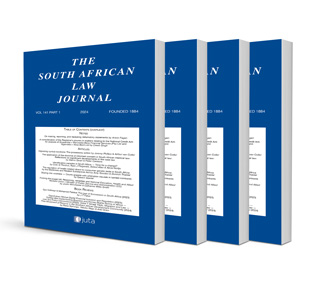
Protection of employees against sexual harassment: The development, successes and shortcomings of the South African legal system
Author: Karin Calitz
ISSN: 1996-2177
Affiliations: Emeritus Professor and Research Associate, Faculty of Law, Stellenbosch University
Source: South African Law Journal, Volume 139 Issue 4, p. 913-945
https://doi.org/10.47348/SALJ/v139/i4a8
Abstract
Despite extensive protection for employees against sexual harassment in the workplace, South African workplaces are still riddled with this harmful conduct. The severe consequences for victims and workplaces necessitate an analysis of the development of South African law to establish its successes, but also the shortcomings that continue to exist. Although there is a matrix of laws protecting employees against sexual harassment, the Employment Equity Act 55 of 1998, which regards harassment as a form of discrimination, is still the primary statute. In this article I argue that the tendency to focus on sexual harassment as a dignity and equality issue does not take sufficient cognisance of sexual harassment as a multifaceted issue involving criminal conduct, which threatens employees’ employment security and impacts on employees’ health and safety. An analysis of case law indicates that many employers have not adopted a policy on sexual harassment, and that some employers and the Commission for Conciliation, Mediation and Arbitration commissioners do not deal with sexual harassment in a gender-sensitive way, which is an approach endorsed by the International Labour Organization’s Violence and Harassment Convention 190 of 2019. This Convention emphasises the need for an inclusive, integrated approach to combat harassment. To align the protection of victims of harassment with the Convention, South Africa adopted a Code of Good Practice on the Prevention and Elimination of Harassment in the Workplace in 2022. This Code, dealing with different kinds of harassment, including sexual harassment, replaced the 2005 Code of Good Practice on the Handling of Sexual Harassment Cases in the Workplace. By comparing the 2005 Code and related jurisprudence to the 2022 Code, the article considers whether sexual harassment is likely to be addressed more effectively under the 2022 Code. The 2022 Code has made certain improvements to the 2005 Code, but the altered definition of sexual harassment indicates the difficulties created by adopting one code to cover both misconduct and discrimination. In addition, aspects of the Convention, such as protecting the health and safety of employees, are not dealt with effectively in the 2022 Code. A separate code should be issued in terms of the Occupational Health and Safety Act to address the psychosocial safety of employees and the compensation of victims in terms of the Compensation for Injuries and Diseases Act 130 of 1993.